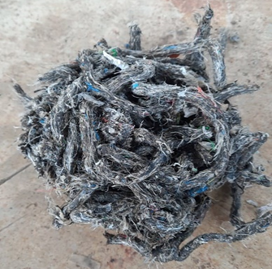Prototype System for Production of Refuse Derived Fuel (RDF-5) from Municipal Solid Waste Using Natural Rubber as Binder
Main Article Content
Abstract
The development of RDF-5 fuel from community waste using natural rubber as a binder was investigated. The results showed that the calorific and heat values were increased proportionately to the amount of rubber added. The ratio with the highest calorific value was 50:50, followed by 75:25, 90:10, and 95:5. The calorific value was 40.67 MJ/kg (9720 kcal/kg), 40.24 MJ/kg (9,617 kcal/kg), 39.28 (9,389 kcal/kg) and 39.18 MJ/kg (9,365 kcal/kg), respectively. Compared with 100:0, have a calorific value of 38.84 MJ/kg (9,284 kcal/kg). The experimental addition of natural rubber as a binder makes the combustion process more complete, resulting in faster fuel ignition time or easier igniting, less ash content, and being environmentally friendly. The research team chose to develop the ratio of 95:5 because the economic analysis showed a fast payback period of only 5.72 years. So, the ratio of 95:5 is the optimal condition that can scale up to the industrial level. The production cost of RDF-5 is 1,935 baht/ton for 50 baht/kg of natural rubber. The amount of emission caused by the combustion process of RDF-5 (95:5) passed the standard. Therefore, the evaluation of this research found that RDF-5 fuels from community waste using natural rubber as a binder. It is one of the attractive alternatives to renewable fuel generation and solid waste management solutions and helps improve the environmental quality of communities.
Article Details

This work is licensed under a Creative Commons Attribution-NonCommercial-NoDerivatives 4.0 International License.
References
Satun Provincial Statistical Office. Satun Provincial Statistical Report, Satun, 2019.
Satun Provincial Natural Resources and Environment Office. Satun Provincial Development Plan, 2019.
Jamradloedluka, J; Lertsatitthanakorn, C. Properties of Densified-Refuse Derived Fuel Using Glycerin as a Binder. Energy procedia, 2015, 100, 505-510.
Maria, F.D.; Gregorio. RDF to energy plant for a central Italian region SUW management system: Energetic and economical analysis. Journal of Thermal Engineering, 2006, 26, 1291-1300.
Punin, W.; Maneewan, S.; Punlek, C. The feasibility of converting solid waste into refuse-derived fuel 5 via mechanical biological treatment process. J Mater Cycles Waste Manag, 2013, 1-11.
Kerdsuwan, S.; Meenaroch, P.; Chalermcharoenrat, T. The novel design and manufacturing technology of densified RDF from reclaimed landfill without a mixing binding agent using a hydraulic hot pressing machine. MATEC Web of Conferences, 2016, 11003.
Jamradloedluka, J.; Lertsatitthanakorn, C. Properties of densified-refuse derived fuel using glycerin as a binder. Energy procedia, 2010, 100, 505-510.
Ioelovich, M. Energy potential of natural, synthetic polymers and waste materials - A Review. Academic Journal of Polymer Science, 2018, 1(1), 9-23.
Prechthai, T.; Visvanathan, C.; Cheimchaisri, C. RDF Production Potential of Municipal Solid Waste. The 2nd Joint International Conference on Sustainable Energy and Environment (SEE 2006). Bangkok, Thailand, 21-23 November 2006.
Sakdapiphanich, J. Natural Rubber Technology: New Knowledge on Natural Rubber. From molecular structure to industrial applications. Natural rubber technology, Bangkok, Technobiz Communications, 2010.
Dusadee, N. The research report on the demonstration of converting waste in universities into energy in the form of heat. Bangkok, National Research Council of Thailand, 2011.
Pollution Control Department. Thailand State of Pollution Report 2011, Ministry of Natural Resources and Environment, 2011.
Pollution Control Department. Announcement of the Ministry of Natural Resources and Environment on the Emission Control Standard for New Power Plants, 2010.


